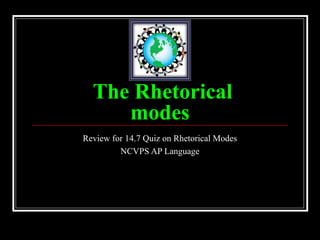
14.7 review rhetorical modes
- 1. The Rhetorical modes Review for 14.7 Quiz on Rhetorical Modes NCVPS AP Language
- 2. Why do we need to know this? Rhetorical modes are the kinds of writing and their purposes. Knowing the rhetorical modes helps us recognize them in essay questions and writing exams. Knowing the styles and the techniques helps us create polished pieces of writing.
- 3. What are the four most common rhetorical modes? Argumentation: The purpose of argumentation is to prove the validity of an idea, or point of view. Description: The purpose of description visually present a person, place, event, or action . Narration: The purpose of narration is to tell a story or narrate an event or series of events . Exposition: The purpose of exposition is to explain and analyze information.
- 4. Argumentation The purpose of argumentation (sometimes also called persuasive writing) is to prove the validity of an idea, or point of view, by presenting sound reasoning, discussion, and argument that thoroughly convince the reader. Persuasive writing is a type of argumentation with the additional aim to urge the reader to take some form of action.
- 5. Examples of argumentation writing Critical review Editorials Job evaluation Letter of recommendation Letters to the editor Résumés/Cover letter
- 6. Descriptive Descriptive writing is characterized by sensory details, which appeal to the physical senses, and details that appeal to a reader’s emotional, physical, or intellectual sensibilities A description is usually arranged spatially but can be chronological. The focus of a description is the scene. Description uses tools such as figurative language, metaphor, and simile to arrive at a dominant impression.
- 7. Description The purpose of description is to re-create, invent, or visually present a person, place, event, or action so that the reader can picture that which is being described. Descriptive writing can be found in the other rhetorical modes.
- 8. Examples of description writing Poetry Journal writing Witness statements Lab reports
- 9. Narration The purpose of narration is to tell a story or narrate an event or series of events. This writing mode frequently uses the tools of descriptive writing. Narration is an especially useful tool for sequencing or putting details and information into some kind of logical order, usually chronological.
- 10. Examples of narrative writing Anecdote: a short tale narrating an interesting or amusing biographical incident Autobiography: a biography written by its subject (or sometimes, in modern usage, composed conjointly with a collaborative writer , styled "as told to" or "with"). Memoir- Closely associated with autobiography , difficult to precisely distinguish from it, is the form of memoir. As a literary genre, a memoir, forms a subclass of autobiography Biography: a description of someone's life, usually published in the form of a book or essay, or in some other form, such as a film. Novel: "short story of something new" is today a long narrative in literary prose. Oral histories: can be defined as the recording, preservation and interpretation of historical information, based on the personal experiences and opinions of the speaker. Short stories: The short story refers to a work of fiction that is usually written in prose, usually in narrative format.
- 11. Exposition The purpose of exposition (or expository writing) is to explain and analyze information by presenting an idea, relevant evidence, and appropriate discussion.
- 12. What are some types of expository writing? Cause and Effect Classification and Division Comparison and Contrast Definition Process Analysis
- 13. Examples of expository writing How-to essays, such as recipes Reports and other instructions Scientific reports Business letters Wikipedia entries Personal letters Term papers News stories Textbooks Press releases Wills
- 14. Cause and effect The defining features of a cause and effect essay are causal chains, careful language, and chronological or emphatic order. This rhetorical mode is often required on History exams. Ex: What led to the outbreak of World War I? Ex: What led to the Japanese Internment?
- 15. Classification and division Classification is the categorization of objects into a larger whole, Division is the breaking of a larger whole into smaller parts. Classification essays are often used in the sciences including sociology and psychology.
- 16. Comparison and Contrast Compare and contrast is characterized by a basis for comparison, points of comparison, analogies, and either comparison by object (chunking) or by point (sequential). Comparison highlights the similarities between two or more similar objects while contrasting highlights the differences between two or more objects. Ex: Puerto Rico and the Dominican Republic Basis for comparison: both geographic areas Comparison point by point- Caribbean cultures, former Spanish colonies, racial mixture due to historical events, Contrast point by point- Size, relationship to the United States, level of development, Citizenship and migration patterns.
- 17. Definition Definition essays explain a term's meaning. Some are written about concrete terms, such as trees, oceans, and dogs, while others talk about more abstract terms, such as liberty, happiness, and virtue. What does it mean to be Latino? What is cultural diffusion?
- 18. Process Analysis Process analysis essays explain the “process” of how to do something, or how something was done. An action is broken down into steps and explained.
